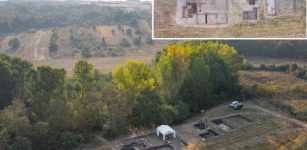Spectacular 6th Century Sword With Runes Found In Anglo-Saxon Grave Near Canterbury In Kent
Jan Bartek - AncientPages.com - Archaeologists have made a significant discovery at an Anglo-Saxon cemetery near Canterbury in Kent, UK, unearthing a remarkably rare sword from the sixth century.
The exact location remains undisclosed due to the valuable nature of the finds. This sword is exceptionally well-preserved and crafted with such skill that it compares to the renowned Sutton Hoo sword found in 1939, which featured a gold hilt and cloisonné garnets.
The weapon was described as being ‘in the top echelons of swords, an elite object in every way’. Photograph: Prof Alice Roberts/BBC/Rare TV
The Anglo-Saxon sword boasts a silver and gilt hilt adorned with intricate patterns. A ring on the pommel may represent an oath ring, indicating allegiance to a leader. The blade features runic inscriptions, and remnants of its leather and wood scabbard lined with beaver fur were also discovered.
At this site, archaeologists have uncovered 12 burials but estimate up to 200 may exist. Male graves include weapons like spears and shields; notably, one grave contained this extraordinary sword along with unexpected jewelry—a gold pendant inscribed with serpent or dragon motifs typically found in female burials—suggesting it might have been gifted by a female relative or passed down as an heirloom.
The discoveries will feature in BBC Two’s forthcoming six-part Digging for Britain series, which shows that an untouched Anglo-Saxon cemetery is now ‘giving up its secrets’. Photograph: Production/BBC/Rare TV
The sword and other artifacts recovered from the burials will be conserved and studied. Once the work is complete, they will be displayed at the Folkestone Museum in Folkestone, Kent
This excavation is being documented for BBC Two’s Digging for Britain program set to air next year. Even at this preliminary stage, findings promise new insights into Anglo-Saxon funerary customs practiced by those who interred their dead here.
Duncan Sayer, the lead archaeologist and professor of archaeology at the University of Central Lancashire, told the Guardian, “We’re keeping the name of the site under wraps. It’s a very rich cemetery. It would be a real tragedy if it became well-known before we’ve excavated it. The sword is really incredible, in the top echelons of swords, an elite object in every way, which is wonderful. It rivals the swords from Dover and from Sutton Hoo.”
See also: More Archaeology News
Historian and TV presenter Professor Alice Roberts will reveal more details about the discoveries in an upcoming BBC show, the six-part Digging for Britain, which starts in early January.
“I’ve never seen a sword that’s so beautifully preserved. It’s an extraordinary Anglo-Saxon cemetery, with really beautifully furnished graves, a lot of weapon burials where you find things like iron spear-points and seaxes, which are Anglo-Saxon knives—and then there’s this astonishing sword,” Professor Roberts said.
Written by Jan Bartek - AncientPages.com Staff Writer






















